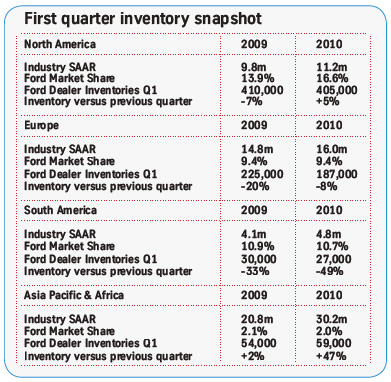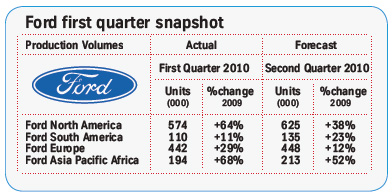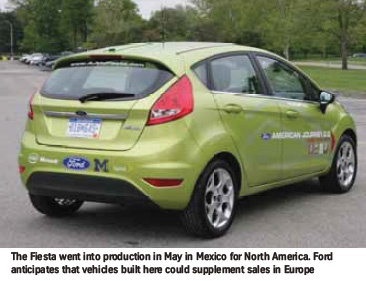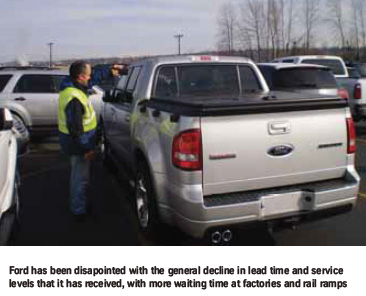
Cross-continental vehicle flows, programming logistics into the order-to-delivery process and keeping an eye on costs are all part of the logistics game at Ford. Christopher Ludwig goes online with Stephen Harley and Walter Lowe.
The recent Ford narrative has been a popular story in the media of late, and one that many believe will be studied in business schools for years to come: Alan Mulally, Ford’s CEO, mortgaged the company during the days of cheaper credit in 2006, revamped the product portfolio, closed factories in North America, retooled others to build smaller cars, opened new plants in growing markets in Asia and sold off unprofitable brands. Meanwhile, under the “One Ford” strategy, the company has striven to unify production, model platforms and processes across the globe.
Partly as a result of its loans, Ford had enough cash to avoid bankruptcy in 2009, earning goodwill from the American taxpayer, but retaining debt that is today around $34 billion. As North American sales began to recover towards the end of 2009 and 2010, Ford outpaced the sector and swung to profitability sooner than anticipated.
 What is retold much less but has nevertheless played a prominent role in Ford’s recent transformation has been the progress of the company’s supply chain management and logistics. Stephen Harley, global executive director for material planning and logistics (MP&L), calls the department’s role in the restructuring “absolutely essential”.
What is retold much less but has nevertheless played a prominent role in Ford’s recent transformation has been the progress of the company’s supply chain management and logistics. Stephen Harley, global executive director for material planning and logistics (MP&L), calls the department’s role in the restructuring “absolutely essential”.
The demands for Ford’s logistics have become more varied and complex. The movement toward global platforms, such as the arrival this year in North America of the European B platform for the Fiesta and C platform for the Focus, has meant both more global sourcing of material as well as a larger amount of cross-continental vehicle exports, including importing smaller cars from Europe as well as the Turkish-built Transit Connect van from Turkey. In May Ford began assembling the European-derived Fiesta at its retooled factory in Cuautitlán, Mexico for the North American market, a supply sourcing model that could eventually see further  cross-shipping with some North American production exported to Europe or other markets to supplement sales there.
cross-shipping with some North American production exported to Europe or other markets to supplement sales there.
“This is just the beginning,” says Harley. “There are a lot more plans that could send North American products to Europe and the rest of the world, and South America shipping into Mexico, etc. in support of a global growth strategy.” Ford’s restructuring and plant closures have also meant important changes to its logistics networks, most notably in North America; for outbound distribution it has meant eliminating mixing yards, rerouting and switching transport modes in some cases. The restructuring has also meant an aggressive push to reduce cost.
Walter Lowe, manager of vehicle logistics in North America, reveals that his objective is to take significant reductions from the company’s annual cost on vehicle distribution. While the downturn may have offered the chance for quicker cost reductions, it has been tougher in a recovering economy with rising fuel prices and a significant amount of truck and rail capacity still idle. This means Ford must constantly improve its logistics flows, find backhaul opportunities and modernise equipment, as well as keep a close eye on its logistics providers’ costs.
Better logistics means better cash flow
However, ever growing freight distances, cost cuts and the need for efficiencies are far from new, of course, even if the  “One Ford” plan and the downturn have made them more radical than before.
“One Ford” plan and the downturn have made them more radical than before.
Perhaps an even more fundamental impact that MP&L brings Ford’s larger strategy has been the focus on cash flow, something that Harley admits was not considered to be as critical in the past. But the need to service Ford’s debt has changed that. In particular, an emphasis has been placed on reducing vehicle inventory, as it frees up cash, helps profits, and ultimately helps Ford’s credit rating.
v Inventory hit a low at the end of the summer 2009 in the US market when it fell to around 30 days. It has since risen as the market returns to life, but remains below the averages of much of the past decade.
“It is a credit to the management team that we’ve resisted the temptation to put all of the inventory back into the network,” says Harley. “After all, it would have looked nice on our books, since we take our profit on a vehicle when it comes off the line. But growth has to be driven by sales, not by inventory.” There is still considerable work to be done if Ford is to keep its inventory low in a healthy way, without sacrificing potential sales. Ford, like most of the industry in North America, has traditionally operated a build-to-stock strategy here that usually required higher levels of inventory. Bringing down these levels in a way that does not just mean forcing down production, but allowing for a stable and more syncronised supply chain, requires sophisticated order-to-delivery systems with high levels of visibility as well as predictability. Developing such a system is precisely what the company is now trying to address.
Global order to delivery
Harley explains that this shift in inventory is a big cultural change for many, and that dealers, especially in the US, are calling out for a better replenishment system. In response Ford is working on rolling out a new global order-to-delivery approach. The system, in Harley’s words, will have a “front end” that effectively offers dealers a more reliable and accurate predictor of new orders, from which Ford can then build more accurate forecasts. The “back end” will mean that this forecast translates into a production plan communicated right back through the multi-tiered supply chain, including logistics providers, to help build better capacity planning and route scheduling.
 While the system is still in development, an important tool in the process has moved beyond pilot phase in North America, called Smart Inventory Management System (SIMS), which is part of a larger order fulfilment tools initiative. According to Harley, while Ford has always given dealers recommended orders, SIMS is designed to anticipate much more–it integrates everything from special incentive campaigns and their likely impacts, and goes down to the detail of colour variations. It offers dealers an allocation that is more likely to be sold, although of course it is not guaranteed.
While the system is still in development, an important tool in the process has moved beyond pilot phase in North America, called Smart Inventory Management System (SIMS), which is part of a larger order fulfilment tools initiative. According to Harley, while Ford has always given dealers recommended orders, SIMS is designed to anticipate much more–it integrates everything from special incentive campaigns and their likely impacts, and goes down to the detail of colour variations. It offers dealers an allocation that is more likely to be sold, although of course it is not guaranteed.
The system then builds production plans around the dealer selection of these recommendations in advance–“promised orders”, according to Harley, as opposed to actual ones–from which Ford builds its manufacturing plan. Once the dealers make the real order, the vehicles go into production, with constant communication and updates for dealers on when production is scheduled, when it has occurred, and estimated delivery times.
“We keep communicating with the dealers so that we can see the production and they can see the vehicle coming and can have a sense of confidence from that,” Harley says. “This should help the dealers to keep fresh vehicles in stock. It is like telling them to sell the wet paint.”
Although the system might sound like Ford exerting influence on what should be sold, Harley sees it as an extension of the “One Ford” vision, particularly in the push toward reducing unnecessary variation and the standardisation of production and supply chain flow. It does not eliminate customer choice but reflects at least what can be standardised within it, such as using a variety of top hats on the same platforms.
The second phase of the system, still in development, will communicate the predicted schedule to supply chain partners, including logistics providers. “It becomes a self-fulfilling prophecy,” says Harley. “If the forecast at the dealer level is right, then the forecast at the supply base and for logistics providers will more likely be right.”
One order system for one Ford
The system follows “One Ford” in another important way–it is both a global product and will have a global rollout. While the piloted introduction begins in North America–in particular with the complete order fulfilment suite replacing 30-year-old dealer order/scheduling systems–it will eventually be brought to every market. Many of its features are also derived from a relatively recent order-to-delivery system in Europe that has also been applied in Asia (see story of Ford Asia Pacific Africa in the April-June 2010 Automotive Logistics, p26), but will be tailored for the local variations in each market. And while the investment in all of the tools that Ford has now made in North America will not be applied immediately to regions where more recent systems are in place, the process of predicted demand and supply chain communication of global order-to-delivery will be. “Global order-to-delivery is a two part equation–one is the process, and the other is the tools. Fortunately, they don’t need to be coincident,” Harley says.
Harley notes in particular the importance of bringing those processes to the fast growing markets in Ford’s Asia Pacific  Africa region, where he sees an opportunity not only for sales but for sidestepping the legacy systems and expectations already in place in developed markets.
Africa region, where he sees an opportunity not only for sales but for sidestepping the legacy systems and expectations already in place in developed markets.
“This is part of the evidence of why ‘One Ford’ is so practical and not just a cliché,” he says. “It’s really simple if you just accept that it is what it says. If you started with the premise, ‘why not one Ford globally?’ then you would have to explain why Asia wouldn’t get the same opportunities as mature markets. We need trust and we need to demonstrate that the process and the tools work in all places. We can’t have unique regional solutions for fundamentally the same process.”
Shifting the lead focus to outbound logistics
Harley observes that for years Ford, and much of the rest of the industry, invested heavily in developing a lean inbound logistics model, with inventory levels greatly reduced and delivery timed to a science. Ford is finally making the same efforts for outbound, with the global order-to-delivery system an essential lead. “We have switched our focus. As we’ve got lean on manufacturing, we are going for lean on outbound and that is part of what is driving our profit,” he says. For vehicle logistics, the role in this process is admittedly more reactive than it is a strategic piece to the global order-todelivery system. As Walter Lowe points out, in Ford’s order cycle in North America, the outbound distribution takes an average of 20% of the total time, versus 50% for the pre-manufacturing process, including the coordination of component demand (final assembly takes the least, lasting a mere day).
While vehicle logistics does not have much impact on determining vehicle inventory, it is very much influenced by both forecasted and actual inventory levels. If the forecast is more accurate on the front end of the order, as the new system intends, it will allow Ford’s logistics providers to build more efficient loads and reduce dwell time at origin or ramps. Currently, Ford has only a limited ability to give reliable forecasts, despite much plying from providers. “Providers often say to me, ‘I don’t believe that you can’t give me a forecast,’” Lowe says. “Well, yes, I can give you one, but it will be an annualised version of a flat line. Now I hope Ford will hit that, but in reality, our sales will never be a flat line, but very jagged, depending on what the market wants. It is not as easy as folks would like it to be.”
More speed and turnover of inventory in the outbound chain, Lowe acknowledged, will come from Ford’s ability to forecast and communicate its production and supply chain schedules. “As we get better at forecasting issues upstream, the vehicle won’t have to be stopped or delayed once its built,” he says. For the road carrier in particular, Harley admits, Ford needs to give better information in advance. Currently, carriers are only able to look at the pool of cars that Ford has already produced to build its current load, thus picking its best delivery plan depending on model and destination. “We need to stop them from doing that by allowing them more insight upstream into our production and rail and ocean movements so that they can begin to plan loads in advance, and thus helping to avoid some cars from dwelling for several days,” Harley says.
North America today
Global order to delivery may be the most important future tool for Ford’s logistics, however it is still in pilot and planning stages. The reality of Ford’s current outbound network in North America is one of considerable flux, and one that, with a betterthan- forecasted recovery thus far in 2010, is showing signs of a shortfall in available transport capacity and service levels. It may seem hard to believe that talk of capacity shortfall could arise already, given the glut of excess trucks, rail wagons and ships the market saw during the crisis of 2008-2009. Lowe himself is somewhat incredulous too, but he is nevertheless struggling to find incremental capacity moving cars by road. “It is a bit of a mystery that we could have been flush with capacity when the industry was selling 17m light vehicles a year, but squeezed with sales on pace for 12m,” says Lowe. “But that is where we are.”
Not everyone entirely agrees that a capacity shortage is present or imminent in the North American market. Susanna Webber, who leads General Motors’ global logistics, has more concerns about the global container shipping industry’s capacity than she does for outbound, including ro-ro shipping (see the GM feature in Automotive Logistics, p16). And at the railway Union Pacific, Kenny Rocker, assistant vice president, believes that the railways will have enough capacity. But there does appear to be concern among car hauliers themselves. At the recent Finished Vehicle Logistics Conference, Michael Wysocki, the CEO of the carrier United Road, predicted that there would be a shortage of equipment and drivers.
The car haulier industry is also facing other structural issues as well, including the financial struggles of several of the largest players in the sector. The top carriers by volumes had been in bankruptcy for several years even before the financial crisis drove down car sales. PTS, which had been the second largest carrier in the US, liquidated in 2008 amidst union resistance to pay cuts and redundancies. Industry experts fear that long-term difficulty and ongoing price pressure in the car industry will weigh further upon the ability of carriers to invest (for more carrier and capacity issues see the report from Finished Vehicle.
But regardless of when a more widescale industry shortage of transport assets might occur, Lowe is unsatisfied even today with the service levels that Ford receives in North America, and he is wary over what a more sustained recovery might bring. “Everything is slower now,” he says. “I am dwelling longer than I have done for years. I can’t get the units moved fast enough from ramps, and we have had to wait for the railroads to bring out extra cars to cover the fact that their velocity is not what it was.”
The evolving Ford network
To understand how the industry got here, it is worthwhile looking at the network changes of the past years. First of all, Ford has shrunk from 23 plants to 13 in North America, obviously changing the requirements for both inbound and outbound logistics. The downturn led to wide-scale scrapping or storage of truck capacity, as well as mass driver redundancies. Railways parked unused equipment along miles of tracks. Ford has also recently moved some vehicles off rail and onto road following the renegotiation of a 12-year contract with a major eastern railway. The original contract, Lowe acknowledges, had been very favourable: it had good rates and did not subject Ford to fuel surcharges. It also included use of four mixing centres across the country to consolidate vehicles before shipping by rail.
“Because of that contract, our rail footprint remained somewhat artificially larger than it would have been,” says Lowe. With the end of the contract, the effective origin destination rates have moved; while the eastern railway remains a lead rail provider, the traffic has been redistributed. As a result, Lowe says that where Ford once had a typical trucking radius of about 250 miles (400km), that range has now been extended to around 300 miles. There are also routes where Ford is using point-to-point trucking, moving trucks combined distances of around 700 miles including the backhaul.
Furthermore, given the carmaker’s reduced manufacturing footprint there is no longer a need for mixing yards. Ford consolidates loads at origin, whether factory or port, or moves vehicles from lower density areas to another origin point. The former mixing yards are now used as ramps.
But it has not all been a one-way shift towards road. In a completely new lane, Ford has begun shipping vehicles out of Mexico by ro-ro ships to the port of Baltimore, where they are consolidated with imported product arriving from Europe.
When should the capacity come back?
Lowe feels that the current challenge is for logistics providers to bring back capacity into the market. Some, he acknowledges, cannot get the financing for equipment; others are again struggling to get the right quality of drivers back. Still more may just be worried about getting burned again should the market putter out.
Harley sympathises: “It will take a very brave operator to put capacity back in. They don’t want to find themselves floating light again, as that wouldn’t do them any good. They have to be slightly ahead of the demand but unfortunately, the demand can’t be there until the capacity exists.”
Lowe already feels the carriers are being too conservative. “What has to be the trigger for a carrier to get in front of demand? While they’re waiting, vehicles are sitting.” When prompted that perhaps providers are waiting for higher rates to make up for shortfalls and make investments, Lowe doesn’t necessarily agree. “I haven’t heard that from them. Nobody has come to me and said that I need bigger pricing to help give you better service,” he says. “And I haven’t invited it, as what I want instead is a more efficient network.”
Ford, of course, has been very tough on price reductions, beginning to crunch cost in earnest several years before the downturn. However, more than cost pressure, Lowe and Harley say the approach should be about understanding a carrier’s cost and then helping to reduce it, particularly for truck transport. “If we understand what drives a carrier’s cost, we might be able to help reduce it, and share the savings,” says Harley. “For example, working together we might be able to help find backhauls and open capacity to help them get that into revenue.”
Lowe acknowledges that some car hauliers are trying to price higher for new bids given the pressure they’ve been under. Until the market pays more, much of the “missing capacity” might stay out of view. However, while Lowe is not satisfied with his service levels, he believes that the laws of supply and demand will eventually bring the trucks back.
“When the demand is really there and climbing back toward 15m [light vehicle sales per year] again and there is really a desperate need, I believe the capacity will show up.” It is hard to prescribe the right medicine, given the volatility of the past few years–but nobody can fault carriers for controlling their assets as tightly as Ford has controlled its own. But if the company’s current trajectory keeps its pace, some carriers would do well to get in front of its transport demands. Both Lowe and Harley speak with the passion of their leader’s “One Ford” vision, and that includes sharing some pain and gain with providers. Time will tell if that part of “One Ford” will go as well as the rest of the strategy so far.


























![Global[1]](https://d3n5uof8vony13.cloudfront.net/Pictures/web/a/d/s/global1_726550.svgz)









